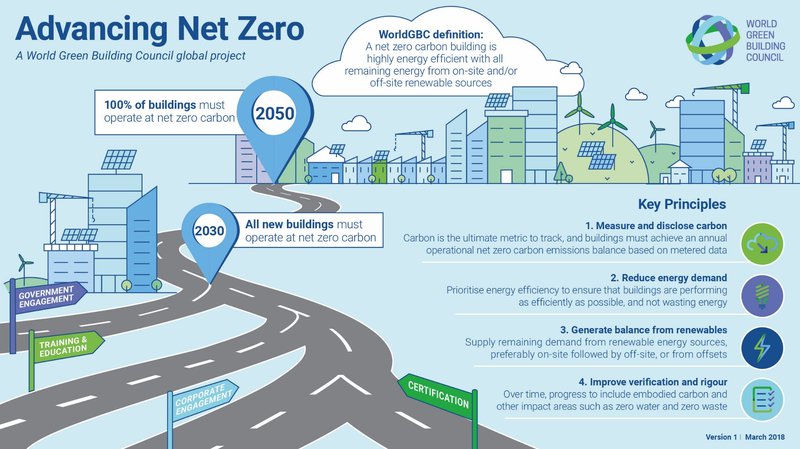
Before COVID-19 struck, it felt like everyone was talking about net zero carbon. The UK Government became one of the first major economies to commit to a legally binding target of net zero emissions by 2050, and a host of big businesses followed suit: Apple, Microsoft, Nestlé, British Airways, BP, Shell, Ikea and more.
Meanwhile, the World Green Building Council’s Net Zero Carbon Buildings Commitment was also gaining traction, securing more signatories. This commitment challenges companies, cities, states and regions to ensure that all buildings they directly operate achieve net zero carbon by 2030, and for them to advocate that remaining buildings do so by 2050.
In short, there was a real momentum gathering around net zero carbon.
Then COVID-19 happened and everyone’s focus shifted. But while most of us weren’t concentrating on our carbon footprints during those dark months in Europe, the enforced lockdown caused a huge drop in energy demand. Incredibly, the UK managed to go two full months without needing to burn coal to generate power. The previous record was only 18 days, 6 hours and 10 minutes (June 2019.)
The green recovery from COVID
Of course, this reduction in energy demand came because of a public health and economic crisis, so no-one was celebrating. However it did get people thinking and talking about the possibility of a ‘green recovery’ from the pandemic, and a renewed focus on net zero carbon.
But with so many targets, initiatives and reports circulating, it’s hard to know where to begin.
Defining net zero carbon and net zero carbon buildings
You’ve probably got a good understanding of what the net zero carbon concept means. It’s about ensuring that each year, the same amount of carbon is removed from the atmosphere as is emitted into it. A growing number of countries are signing up to net zero carbon targets; some of them are even committing their nation to achieving it well before 2050.
But what about net zero carbon buildings? What exactly is one of those? According to the World Green Building Council (WGBC), a net zero carbon building is “a building that is highly energy efficient and fully powered from on-site and/or off-site renewable energy sources and offsets.” It makes the point however, that offsets should be considered only as a last resort.

[Source: World Green Building Council]
We have to begin with energy efficiency
Although the term ‘energy efficiency’ has fallen out of favour in the last 15 years, the need to do it hasn’t gone away. If we are going to halt the effects of climate change, we need to reduce energy demand. This is listed as the second key principle in the WGBC’s infographic, shown above.
“Globally, energy efficiency measures could deliver a 48% reduction in global emissions by 2030, with 43% of those coming from buildings”
But just how important is energy efficiency to the net zero carbon targets? The WGBC provides the answer on its website: “Globally, energy efficiency measures could deliver a 48% reduction in global emissions by 2030, with 43% of those coming from buildings” [Source: Net Zero Carbon Buildings Commitment web page — FAQ ‘Are there any minimum benchmarks or codes that need to be met for energy efficiency?’]
A 48% reduction, of which 43% could come from improving building performance — that’s a huge opportunity! Unfortunately, this often gets lost in all the excitement around clean energy, renewables and carbon capture.
A more recent report from the IEA also supports this view. Its Sustainable Recovery plan (June 2020) suggests that the largest overall emissions reductions should come from energy efficiency measures. Why? Because it says, these measures “score highly in terms of effectiveness…They improve self-sufficiency, reduce exposure to extended supply chains and reduce the potential impacts of volatile commodity prices, while providing an immediate boost to local jobs”. It also points out that energy efficiency measures save emissions while also saving money.
The IEA’s plan admits that in the past, “efficiency measures have not attracted as much attention as they deserve” but that “the unique set of circumstances created by Covid-19 mean that this could be an opportunity for their potential to be seized.”
So there we have it: the time is right for energy efficiency to make a resurgence and it has the potential to make a major contribution to the net zero carbon targets. Energy efficiency is where we need to begin.
Energy efficiency relies on data
To improve energy efficiency in buildings of course, energy service providers and consultants need data on a building’s energy usage. The second stage of the World Green Building Council’s Commitment is ‘Disclose — Measure, disclose and assess annual asset and portfolio energy demand and carbon emissions.’ But before you can disclose what your current carbon emissions are, you first need to be able to measure them accurately.
The problem is, as we’ve outlined in previous blogs, getting hold of good energy data for your buildings is a real challenge. This is largely because of the way the industry is structured and the complex relationships between utility suppliers, meter operators, and data collectors.
The technology and infrastructure exist to provide usage data at half-hourly resolution on a daily basis, but the reality is that this data isn’t getting through to the right people — facilities managers, energy management consultants, and sustainability experts.
How to get better quality energy data
The solution to this problem has two parts. Firstly, you need to be able to setup and maintain high quality data feeds. The best way to do this is for the manager of the building to directly appoint a data collector of their choice, rather than one that’s been automatically appointed by the utility supplier. This way they can ensure they select a data collector who understands the importance of reliable data at half-hourly resolution, and can provide it to them over a long period of time — we’d suggest a contract that lasts three to five years.
Secondly, you need advanced energy data management software for buildings. This can automatically collect all of the data, aggregate it and present it in a way that can be quickly and easily understood — through charts, graphs, maps and gauges. This ensures you spend much less time maintaining a multitude of data sources and dealing with data providers, and much more time on generating insights and outcomes that can help you improve energy efficiency.
The Fabriq platform can help with both parts of the solution. Uniquely, it has a specific module dedicated to the management of data feeds. As part of our onboarding process, we’ll help you set this up correctly and provide comprehensive training on how to maintain your data inputs.
We can also advise you on the process of finding a good data collector so you can secure high quality energy data for your buildings over the next few years. We’ve worked with many data collectors and have developed strong relationships with the key players.
What Low Carbon Alliance is doing
One of our newest clients, Low Carbon Alliance (LCA), has recognised the importance of getting better quality energy data first. LCA helps organisations reduce carbon emissions from property, energy and transport, through a wide range of services — from assessing energy efficiency to integrating renewable energy into buildings and establishing Corporate Power Purchase Agreements (CPPAs).
LCA has a framework to help guide its clients towards net zero carbon, which starts with these two steps:
- Monitor and measure energy-use in real-time on an overall portfolio and individual asset level
- Identify how to reduce operational energy use now and in the future.
It uses the Fabriq energy data management platform to help its clients with step 1 and to monitor the success of any measures put in place during step 2.
Net Zero Carbon Buildings Webinar
In this webinar recording you can find out more about net zero carbon buildings targets and how good energy data is essential for meeting them. Click here to watch now.

